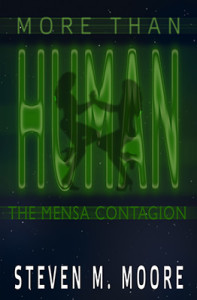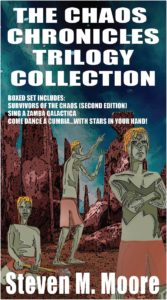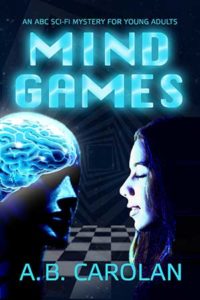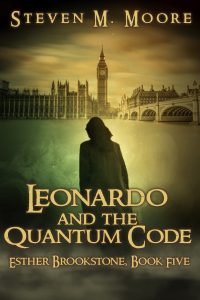ETs…
I’m not a famous sci-fi author (some would argue I’m not even an author!), but I share at least one thing in common with the three most famous ones, Isaac Asimov, Arthur C. Clarke, and Robert Heinlein. (Many so-called sci-fi addicts haven’t read their stories, though. They’re from my generation or earlier, but no more recent ones are as good…including me!) What do we have in common? They were all scientists, and so was I. Asimov was a biochemist, Clarke was…well, let’s just call him an applied physicist/engineer, and Heinlein was an astronomer; I once made my living as a physicist, working in R&D.
Clarke was the misfit in that famous trio because he had a few ETs in his stories, most notably in the Rama series; the other two didn’t, as far as I can remember (and I’ve read a lot of their books!). Asimov explained away his avoidance of ETs in the entire extended Foundation series (it goes far beyond that famous trilogy) by using his novel, The End of Eternity: the eternals of that story arranged everything so that humans would be alone…for all eternity! Heinlein just avoided ETs altogether without explanation, although he wrote about some very wild creatures out there among the stars sometimes.
Clarke almost avoided ETs in Rama, but he couldn’t resist bringing them in end at the end to prove God is an engineer. Other less famous sci-fi authors have avoided ETs too. I suspect they, and this might explain the big three’s hesitancy, realized that ETs are hard! Writing about them is difficult, in other words. I know that from personal experience.
Some authors do ETS quite well, though, by easing into their strangeness. Card probably did it best with his Ender series, although you don’t actually meet any of those hive fellows (and just the queen at that) until the second book. Pohl pulled it off in his HeeChee series, although you never meet those fellows either because they’ve disappeared beyond the event horizon of a black hole. Hogan’s Giants series had more humanoid ETs; they were OK, but you only meet them in the second book (his The Proteus Operation was a better story, and it had no ETs). But looking back, I can tell all those master writers and ET creators were struggling.
 That’s why, when I set out to write about ETs, I was wary of them. I was afraid I’d commit the common mistake of making them seem too human, like all of the ETs mentioned with the exception of Card’s—some more, some less, but tainted by anthropomorphism. I said to myself, “Steve, old boy, an ET is supposed to be…well, strange, alien, culturally different, and differently thinking than humans.” So…I decided to ease into writing about ETs too (that discounts some earlier juvenile works that never saw the light of day).
That’s why, when I set out to write about ETs, I was wary of them. I was afraid I’d commit the common mistake of making them seem too human, like all of the ETs mentioned with the exception of Card’s—some more, some less, but tainted by anthropomorphism. I said to myself, “Steve, old boy, an ET is supposed to be…well, strange, alien, culturally different, and differently thinking than humans.” So…I decided to ease into writing about ETs too (that discounts some earlier juvenile works that never saw the light of day).

The more recent More than Human: The Mensa Contagion is one later novel that represents the quickest route I took—still easing into ET writing, but all in one novel (and “they” discover us, sort of!). But earlier, my “Chaos Chronicles Trilogy” and subsequent stories (Rogue Planet and the Dr. Carlos stories, for example) starts out without ETs in the first novel, Survivors of the Chaos, although their remains are found on a moon of Saturn. The reader never meets any of those fellows, though, until the third novel! When I finally introduced real live ETs in the second novel, Sing a Zamba Galactica, I tried to make them as strange as possible, given that I’m a human writer (I suppose all sci-fi writers must explain to their readers that they are indeed human?)—those ETs are physically, culturally, and linguistically very non-human. They’re not quite as strange as Card’s, but they’re very weird. Yet they like humans so much, they become more like them, or humans became more comfortable with them, both ignoring differences as good friends will often do. They became right at home in my stories, especially in A. B. Carolan’s The Secret of the Urns and Mind Games. (Urns also has a new set of ETs, though, Asako’s friends. ETs can be friends or villains; I prefer friends.) Of course, that the strangest of my ETs become more human-like is all my fault. I fell into the trap I’d tried to avoid. Creating believable ETs is hard!

The easy way out for sci-fi authors, other than avoiding ETs altogether like Asimov and Heinlein, is to make them monstrous, misshapen, gross, and often evil caricatures of human beings. Niven’s Kzins and Star Wars‘ Jabba the Hutt are examples. Or, an author can turn them into cute and cuddly creatures. Pohl’s HeeChee and Star Wars’ ewoks are examples. In that second book of my trilogy, I showed that this doesn’t have to be an “exclusive or” in the logical sense: The Tali are evil caricatures of human beings who appear to be cute and cuddly! (If you join the majority, you might as well mix things up a bit to set everyone’s head spinning!). It’s hard to make them really strange in either case. (In that same second trilogy novel that readers seem to avoid, I go beyond Heinlein’s collective hive concept to the Singer and the Swarm, both of them very strange collective intelligences, so my track record is a bit mixed.)
Asimov, even though he’s my hero, failed to meet the challenge of creating believable ETs; Heinlein too. Maybe I compensated a bit for them? In any case, their fame suffered little for that failure, of course, so maybe creating believable ETs isn’t all that important?
***

Comments are always welcome.
Leonardo and the Quantum Code. Trouble again finds Esther Brookstone on her home turf. An old friend from her Oxford days is developing encoding and decoding algorithms that involve entangled quantum states and quantum computers, all motivated by some of Leonardo Da Vinci’s ideas found in a newly discovered notebook of the artist. His project is financed by MI5, but both the Americans and Russians want his results…and so does a mysterious stranger. Cloak-and-dagger suspense abound in this fifth novel of the series. Coming soon Draft2Digital to all quality ebook retailers (but not Amazon nor Smashwords)!
Around the world and to the stars! In libris libertas!

June 30th, 2021 at 3:11 pm
I believe Asimov wrote an essay explaining why ET’s, if they showed up here on Earth, would look more like us than we think – they’d be similar size and likely bipedal with some type of appendage for manipulating the environment. It’s been a LONG time since I read it, but I found it interesting.
Then again, his aliens in THE GODS THEMSELVES were interesting in that triad reproductive analogy and in their descriptions, such as they were. I remember picturing them almost as blobs in their immature stages. I liked that book a lot.
I feel that you have done ETs as well as almost anyone.
July 3rd, 2021 at 5:55 am
Hiya Scott,
Thank you for reminding me of that early Asimov work. I’m now wondering if that’s unique. As for the essay, I think I was remembering one where he used End of Eternity as an explanation. Or was it an interview? He and I have something else in common: avid Science News readers.
Thanks for the kudos about ETs. My initial portrayal of the Rangers painted them more strange but they became more “human” as their story continued. Perhaps that’s not a failure but a lesson for today’s intolerant people: Strangeness becomes inconsequential if we come to understand it.
r/Steve